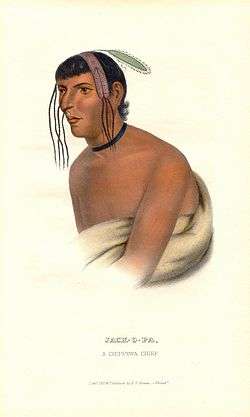Shakopee (Dakota leaders)
Shakopee or Chief Shakopee may refer to any of the three Mdewakanton Dakota leaders who lived in the early 19th century. The name comes from the Dakota Shák'pí meaning "Six".
Shakopee I
Shakopee I (c.1750-1827). Shakopee was given this name when his wife, White Buffalo Woman, gave birth to sextuplet boys. Shakopee Lake near Mille Lacs Lake was named after him. Shakopee met Major Stephen Harriman Long at the mouth of the Minnesota River in 1817, when Long came up to distribute the presents which Lieutenant Zebulon Pike had contracted to send them 12 years earlier with the Pike's Purchase, and Long found Shakopee very offensive. Shakopee was executed at Fort Snelling in June 1827 by running a gauntlet by some Ojibwa as part of his punishment for murdering some Ojibwa before.
Shakopee II

Shakopee II or the Eaglehead (1794–1857). Shakopee was the adopted son of Shakopee I, and the biological twin son of the Ojibwa leader Ozaawindib "Yellow Head". He identified himself equally as being both Ojibwa and Dakota, but increasingly after signing the 1825 Treaty of Prairie du Chien (both as "Sha-co-pe" (the Sixth) and as "The Sees"), he was forced to identify himself exclusively as Dakota. Despite the pressures, he was also signatory to the 1826 Treaty of Fond du Lac (as "Chau-co-pee" and as "Jack-o-pa" by Bird), 1837 Treaty of St. Peters (as "Sha-go-bai"), and the 1842 Treaty of La Pointe (as "Sha go bi") of the Ojibwas. Shakopee also was a signatory to the Treaty of Mendota of August 5, 1851, (as "Sha-k'pay") in which he and the other Dakota chiefs were pressured into selling 24 million acres (97,000 km2) for pennies an acre. Food and money from the federal government was to be distributed to the Indians as part of the treaty, but several years later with the American Civil War, United States broke their treaty obligations. The city of Shakopee, Minnesota and the nearby Shakopee Lake were named after him. Shakopee served as a guide to Joseph Nicollet in part of the exploration of the upper Mississippi, and providing details on its tributaries, such as Rice Creek near Fridley, Minnesota. In Ojibwe, he was called Zhaagobe, and his descendants who identified themselves as Ojibwa rather than Dakota are surnamed either "Shaugobay" or "Shagobince".
Shakopee III
Shakopee III, also known as Eatoka, or Shakpedan in Dakota or Zhaagobens in Ojibwe, both meaning "Little Shakopee" (1811–1865). Shakopee was the son of Shakopee II. He was born in the village of Shakopee. He became a chief with the death of his father. During the Dakota War of 1862. he was a war leader of the Yankton Dakota in Minnesota. He escaped to Canada after the conflict. With fellow leader Medicine Bottle he was betrayed, drugged, kidnapped, and turned over to U.S. forces. Shakopee and Medicine Bottle were executed at Fort Snelling on November 11, 1865 for their participation in the Dakota War of 1862.[1] While he was held prisoner at Fort Snelling, a photograph of Shakopee III was taken in 1864.
He is the namesake of the Little Six Casino in Shakopee, Minnesota.
References
- ↑ Winks, Robin W. (1960). The Civil War Years: Canada and the United States, Baltimore : Johns Hopkins Press, 1960, pg. 174